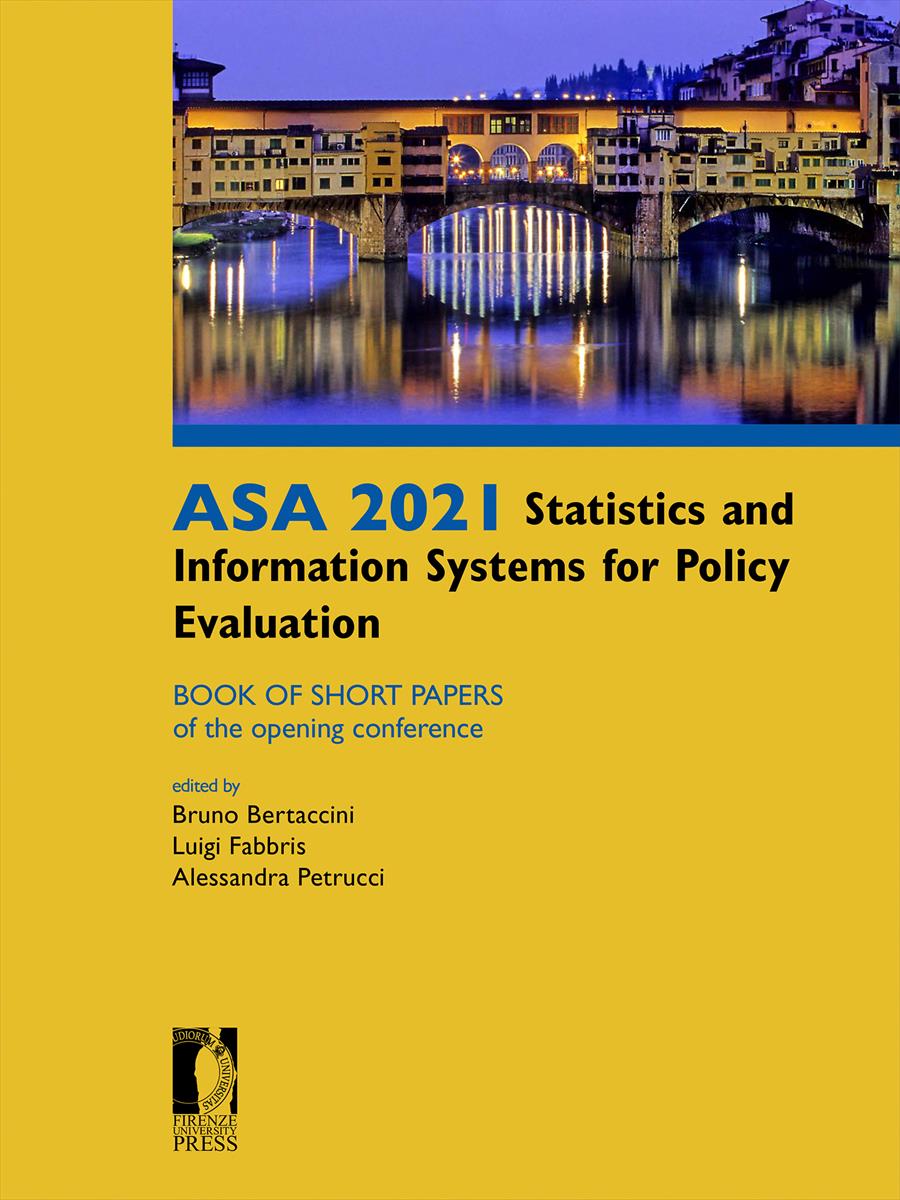- ASA 2021 Statistics and Information Systems for Policy Evaluation
- Edited by Bruno Bertaccini, Luigi Fabbris, Alessandra Petrucci
Exploring the intention to walk: a study on undergraduate students using item response theory and theory of planned behaviour
- Carla Galluccio
- Rosa Fabbricatore
- Daniela Caso
- © 2021 Author(s) |
- CC BY 4.0
- DOI: 10.36253/978-88-5518-304-8.30
Physical activity is one of the most basic human functions, and it is an important foundation of health throughout life. Physical activity apports benefit on both physical and mental health, reducing the risk of several diseases and lowering stress reactions, anxiety and depression. More specifically, physical activity is defined as "any bodily movement produced by skeletal muscles that require energy expenditure" (World Health Organization), including in this definition several activities. Among them, walking has been shown to improve physical and mental well-being in every age group. Despite that, insufficient walking among university students has been increasingly reported, requiring walking promotion intervention. In order to do this, dividing students based on their intention to walk might be useful since the intention is considered as the best predictor of behaviour. In this work, we carried out a study on university students' intention to walk and some of its predictors by exploiting Item Response Theory (IRT) models. In particular, we inspected the predictors of intention by mean of Rating Scale Graded Response Model (RS-GRM). Then we used the Latent Class IRT model to divide students according to their intention to walk, including predictors' scores as covariates. We chose the intention's predictors according to an extension of the Theory of Planned Behaviour (TPB), with both classic and additional variables. The formers are attitude toward behaviour, subjective norms, and perceived behavioural control, whereas we used risk perception, self-efficacy, anticipation, self-identity and anticipated regret as additional variables. Data was collected administrating a self-report questionnaire to undergraduate students enrolled in the Psychology course at Federico II University of Naples.
- Keywords:
- Walking,
- Theory of Planned,
- Behaviour,
- Item Response Theory,
University of Florence, Italy - ORCID: 0000-0003-1154-3601
University of Naples Federico II, Italy - ORCID: 0000-0002-4056-4375
University of Naples Federico II, Italy - ORCID: 0000-0002-6579-963X
- Ajzen, I. (1991). The theory of planned behavior. Organizational behavior and human decision processes, 50(2), pp. 179–211.
- Ajzen, I. (2002). Constructing a TPB questionnaire: Conceptual and methodological considerations.
- Bacci, S., Bartolucci, F., Gnaldi, M. (2014). A class of Multidimensional Latent Class IRT models for ordinal polytomous item responses. Communications in Statistics-Theory and Methods, 43(4), pp. 787–800.
- Bartolucci, F., Bacci, S., Gnaldi, M. (2015). Statistical analysis of questionnaires: A unified approach based on R and Stata. CRC Press, Boca Raton, (FL).
- Caso, D., Carfora, V., Capasso, M., Oliano, D., Conner, M. (2020). Using Messages Target- ing Psychological versus Physical Health Benefits to Promote Walking Behaviour: A Ran- domised Controlled Trial. Applied Psychology: Health and Well-Being.
- Dayton, C.M., Macready, G.B. (1988). Concomitant-variable latent-class models. Journal of the american statistical association, 83(401), pp. 173–178.
- Fishbein, M., Ajzen, I. (2010). Predicting and changing behavior: The reasoned action ap- proach. Taylor & Francis, New York, (NY).
- Lowe, R., Eves, F., Carroll, D. (2002). The influence of affective and instrumental beliefs on exercise intentions and behavior: A longitudinal analysis. Journal of Applied Social Psychol- ogy, 32(6), pp. 1241–1252.
- Muraki, E. (1990). Fitting a polytomous item response model to Likert-type data. Applied Psychological Measurement, 14(1), pp. 59–71.
- Penedo, F.J., Dahn, J.R. (2005). Exercise and well-being: a review of mental and physical health benefits associated with physical activity. Current opinion in psychiatry, 18(2), pp. 189–193.
- Petrillo, G., Caso, D., Donizzetti, A.R. (2004). Questionario “Salute e benessere nel mondo gio- vanile”, in Promuovere la salute nei contesti educativi: comportamenti salutari e benessere tra gli adolescenti, eds. G. Petrillo, D. Caso, Franco Angeli, Milano, (IT), pp. 401–407.
- Reckase, M. (2009). Multidimensional Item Response Theory. Springer, New York, (NY).
- Ries, F., Hein, V., Pihu, M., Armenta, J.M.S. (2012). Self-identity as a component of the theory of planned behaviour in predicting physical activity. European Physical Education Review, 18(3), pp. 322–334.
- Samejima, F. (2016). Graded response model, in Handbook of Item Response Theory, ed. W.J. van der Linden, Springer, New York, (NY), pp. 95–108.
- Stephan, Y., Boiche, J., Trouilloud, D., Deroche, T., Sarrazin, P. (2011). The relation between risk perceptions and physical activity among older adults: a prospective study. Psychology & health, 26(7), pp. 887–897.
- Sun, G., Acheampong, R.A., Lin, H., Pun, V.C. (2015). Understanding walking behavior among university students using theory of planned behavior. International journal of environmental research and public health, 12(11), pp. 13794–13806.
- Schwarz, G. (1978). Estimating the dimension of a model. The Annals of Statistics, 6(2), pp. 461–464.
- Tudor-Locke, C., Bassett, D.R. (2004). How many steps/day are enough?. Sports medicine, 34(1), pp. 1–8.
- World Health Organization. (2018). Physical activity. https://www.who.int/news-room/fact-sheets/detail/physical-activity.
- Wing Kwan, M.Y., Bray, S.R., Martin Ginis, K.A. (2009). Predicting physical activity of first- year university students: An application of the theory of planned behavior. Journal of Amer- ican College Health, 58(1), pp. 45–55.
Chapter Information
Chapter Title
Exploring the intention to walk: a study on undergraduate students using item response theory and theory of planned behaviour
Authors
Carla Galluccio, Rosa Fabbricatore, Daniela Caso
Language
English
DOI
10.36253/978-88-5518-304-8.30
Peer Reviewed
Publication Year
2021
Copyright Information
© 2021 Author(s)
Content License
Metadata License
Bibliographic Information
Book Title
ASA 2021 Statistics and Information Systems for Policy Evaluation
Book Subtitle
Book of short papers of the opening conference
Editors
Bruno Bertaccini, Luigi Fabbris, Alessandra Petrucci
Peer Reviewed
Publication Year
2021
Copyright Information
© 2021 Author(s)
Content License
Metadata License
Publisher Name
Firenze University Press
DOI
10.36253/978-88-5518-304-8
eISBN (pdf)
978-88-5518-304-8
eISBN (xml)
978-88-5518-305-5
Series Title
Proceedings e report
Series ISSN
2704-601X
Series E-ISSN
2704-5846
